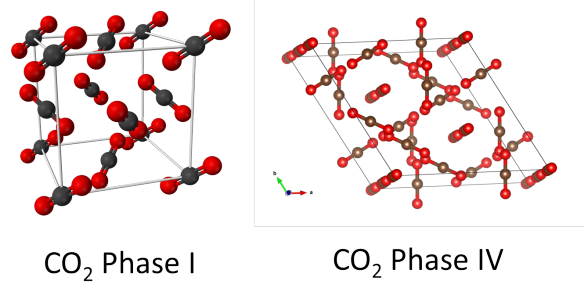Solid carbon dioxide
What does it look like?

What is it?
Solid carbon dioxide, a.k.a. dry ice, is a well-known cooling agent amongst meat packers and ice cream makers. Where at normal atmospheric pressure, water freezes at 0 °C, CO2 solidifies at -78.5 °C. Besides its lower temperature, dry ice's main advantage over water ice is that it is a refrigerant with no liquid residue. That is, it goes from solid to gas without an intervening liquid phase (at least at normal atmospheric pressure); a process called sublimation. Dry ice is also popularly used in smog machines.
High pressure and temperature phases of solid CO2 are especially important for understanding planetary interiors [2-3] and star formation [4]. Like solid water, solid CO2 has several polymorphs [1]. So far there have been 7 different polymorphs of solid CO2 identified. Below is the phase diagram of solid CO2 at high temperature and pressure. Phases I, III, and VII are typical molecular solids, while phases V and VI are extended phases similar to those of silicate (SiO2). Phase II is a poorly understood intermediary phase. The nature of phase IV is starting to come into view.
![Where all the structures of CO2 sit in pressure and temperature space, from reference [4]](https://www.iycr2014.org/__data/assets/image/0014/109310/co2_phase.gif)
Where all the structures of CO2 sit in pressure and temperature space, from reference [4]
Iota et al. reported results indicating that that phase V is an extended covalent solid with carbon-oxygen single bonds [7], a result subsequently confirmed by Santoro et al. [8] and Datchi et al. [10]. Seto et al. likewise solved the crystal structure of solid CO2-V which is consistently interpreted in terms of a tetragonal unit cell [11]. Sun et al. reported that phase VI is also amorphous, layered and tetrahedral [9]. These results also suggest that CO2 may be present in the Earth's mantle with structures that are similar or identical to structures of SiO2 having either 4- or 6-coordinated carbon atoms.
The totality of the all the investigations of solid CO2 reveals a very complex picture of changing structure as a function of temperature and pressure. There are still several open questions and a need for perhaps new techniques in X-ray diffraction to resolve some of the issues. What is also interesting about this line of research is the role of electronic structure calculations [12,13] and complementary experimental methods, e.g. X-ray Raman spectroscopy [15].
References
1. Yoo, C. et al., Crystal structure of carbon dioxide at high pressure: "Superhard" polymeric carbon dioxide. Physical Review Letters, 1999. 83(26): p. 5527.
2. Matson, J., "Deep Freeze: Mars Orbiter Finds Massive Stores of Buried Dry Ice," Scientific American, April 21 2011, Nature Publishing Group
3. Malin, Michael C., Michael A. Caplinger and Scott D. Davis. "Observational evidence for an active surface reservoir of solid carbon dioxide on Mars." Science 294, no. 5549 (2001): 2146-2148.
4. Nummelin, A., D. C. B. Whittet, E. L. Gibb, P. A. Gerakines and J. E. Chiar. "Solid carbon dioxide in regions of low-mass star formation." The Astrophysical Journal 558, no. 1 (2001): 185.
5. Datchi, Frédéric, Valentina M. Giordano, Pascal Munsch and A. Marco Saitta. "Structure of carbon dioxide phase IV: Breakdown of the intermediate bonding state scenario." Physical Review Letters 103, no. 18 (2009): 185701.
6. Park, J-H., C. S. Yoo, V. Iota, H. Cynn, M. F. Nicol and T. Le Bihan. "Crystal structure of bent carbon dioxide phase IV." Physical Review B 68, no. 1 (2003): 014107.
7. Iota, V., C. S. Yoo and H. Cynn. "Quartzlike carbon dioxide: An optically nonlinear extended solid at high pressures and temperatures." Science 283, no. 5407 (1999): 1510-1513.
8. Santoro, Mario, Federico A. Gorelli, Roberto Bini, Giancarlo Ruocco, Sandro Scandolo and Wilson A. Crichton. "Amorphous silica-like carbon dioxide." Nature 441, no. 7095 (2006): 857-860.
9. Sun, Jian, Dennis D. Klug, Roman Martoňák, Javier Antonio Montoya, Mal-Soon Lee, Sandro Scandolo and Erio Tosatti. "High-pressure polymeric phases of carbon dioxide." Proceedings of the National Academy of Sciences 106, no. 15 (2009): 6077-6081.
10 Datchi, Frédéric, Bidyut Mallick, Ashkan Salamat and Sandra Ninet. "Structure of Polymeric Carbon Dioxide CO2-V." Physical Review Letters 108, no. 12 (2012): 125701.
11. Seto, Y., D. Nishio-Hamane, T. Nagai, N. Sata and K. Fujino. "Synchrotron X-ray diffraction study for crystal structure of solid carbon dioxide CO2-V." In Journal of Physics: Conference Series, vol. 215, no. 1, p. 012015. IOP Publishing, 2010.
12. Plašienka, D. and Martoňák, R., "New amorphous forms of solid CO2 from ab initio molecular dynamics", arxiv/1307.3854
13. Li, Jinjin, Olaseni Sode, Gregory A. Voth and So Hirata. "A solid–solid phase transition in carbon dioxide at high pressures and intermediate temperatures." Nature Communications 4 (2013).
14. Bonev, S. A., Francois Gygi, T. Ogitsu and G. Galli. "High-pressure molecular phases of solid carbon dioxide." Physical Review Letters 91, no. 6 (2003): 065501.
15. Shieh, Sean R., Ignace Jarrige, Min Wu, Nozomu Hiraoka, S. Tse John, Zhongying Mi, Linada Kaci, Jian-Zhong Jiang and Yong Q. Cai. "Electronic structure of carbon dioxide under pressure and insights into the molecular-to-nonmolecular transition." Proceedings of the National Academy of Sciences 110, no. 46 (2013): 18402-18406.






